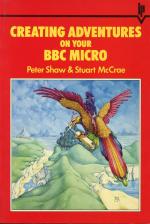
C&VG
 1st September 1985
1st September 1985
Categories: Review: Book
Author: Keith Campbell
Publisher: Interface
Machine: BBC Model B
Published in Computer & Video Games #47
Creating Adventures On Your BBC Micro
This book opens with a chapter entitled What Is An Adventure? which confines itself to a discussion of D&D-type games. No attempt is made to describe the historical development of computer Adventure games which are much more varied than pure D&D, and in no way does justice to the concept of the Adventure format as a vehicle for interactive fiction.
The type of Adventure program described is quite limited, being confined to movement in compass directions, objects and monsters. The programming tutorial starts by explaining how to create a logical and consistent "adventure map" by use of a two-dimensional numeric array. This is followed by a chat about the need to create the historical background to the Adventure.
I must admit that I have long scorned detailed backgrounds to Adventures, being heavily suspicious that they are contrived only to colour an otherwise pretty drab and unbelievable game.
Next follows a chapter on processing input commands and the author's pre-occupation with the Spectrum shows through in his reference to "string slicing". This, plus other chapters on picking up and dropping things and adding graphics and further vocabulary, all contain program listing examples.
There follows a complete mini-adventure written in the format described. The remaining 60 of the 120 odd pages in the book contain program listing for seven other Adventures, written in a different format by various other authors.
Both the title and the authors' introduction give the impression that this book will teach you how to write a complex Adventure program.
Whilst it is true that if you have never given any thought to how such a program works you will get a few ideas from reading the book, it is also probably true that you'd be better off without them!
The main array controlling the map holds fairly small whole numbers and the omission of using and explaining integer precision for this and other variables is unforgivable in a book teaching a programming technique. The use of integer precision, where practicable, is a major factor in reducing response time and memory used (a must for the small memory BBC).
At the end of the listing of the author's own Adventure follows a paragraph announcing, out of the blue, that the program was built around an adjective routine. This completely lost me, since no adjective was mentioned, and the discussion seemed to centre on stripping off the indefinite article from an input.
All in all, I do not find much to recommend the book and, at £5.95, do not feel it is very good value. In view of the programming techniques advocated and apparent in the listings, I would disagree with the description of the authors on the back cover as "expert adventure programmers". For real expertise, Peter Killworth's How To Write Adventure Games at the same price, leaves the book standing.
Scores
BBC Model B Version| Overall | 35% |


